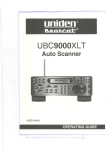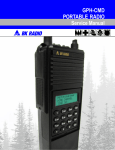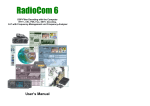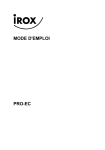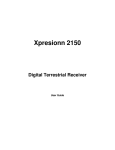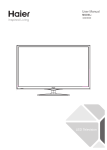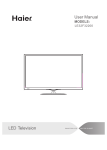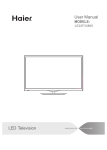Download BENDIXKing EMH Owner`s manual
Transcript
EMH Mobi l eRadi o Owner ' sManual TABLE OF CONTENTS Introduction .................................................................................. Basic Operation........................................................................... Code Guard Operation................................................................. EMH Radio Controls .................................................................... Button Functions......................................................................... Built-in Features ......................................................................... Keypad Microphone Operation.................................................... Channel Scan .............................................................................. Priority Scan................................................................................ Busy Channel .............................................................................. Installation.................................................................................... Service......................................................................................... 1 2 3 4 4 7 8 10 11 13 14 16 INTRODUCTION The Bendix/King EMH radio utilizes a microprocessor core allowing features and performance previously unavailable in a mobile radio. It features a 38 MHz operating frequency spread, computer programmability, alphanumeric display, compact size, and built-in CTCSS/CDCSS. Please take a moment to acquaint yourself with the information in this manual to assure optimum performance from the radio. FCC REQUIREMENTS The EMH radio must be properly licensed by the Federal Communications Commission prior to use. Your Bendix/King dealer can assist you in meeting this requirement. SAFETY PRECAUTIONS A. Do not operate the transmitter in close proximity to blasting caps. B. Do not operate the radio in an explosive atmosphere (petroleum fuels, solvents, dust, etc.). C. Do not operate the transmitter if a person outside the vehicle is within two feet of the antenna or touching the antenna. D. Do not install the radio in a closed compartment that contains an LP gas container or its fittings. E. The radio must be properly grounded. F. The equipment must be installed and serviced by a qualified technician. EMH Owner’s Manual 1 BASIC OPERATION RECEIVE TURN POWER ON by rotating the OFF-VOL knob clockwise past the Off detent. by pressing the MON button to hear squelch noise. Rotate the OFF-VOL knob to set a comfortable volume level. Press the MON button again to stop squelch noise. SET VOLUME (if applicable) by pressing the GRP button and rotating the Channel Select knob. Press the GRP button again to view the group label (alphanumeric mode). Press the GRP button one more time or allow to time out to return to channel select mode. See "GRP" on page 6. SELECT A CHANNEL GROUP by rotating the Channel Select knob. After reaching the highest channel number, the radio wraps to channel 1. SELECT A CHANNEL THE ALPHANUMERIC DISPLAY shows either channel numbers (numeric mode) or channel labels (alphanumeric mode). The display mode and channel labels are programmed by the technician along with group labels (if applicable) and channel frequencies. The display shows slightly different indications during Channel Scan and Priority Scan operation in alphanumeric and numeric modes. See the illustrations on pages 10 and 11. TRANSMIT PTT (Push To Talk) switch on the microphone. The TX annunciator appears on the display and the red Transmit Indicator glows while the PTT switch is pressed. Talk in a normal voice with the microphone approximately 1 to 2 inches from your mouth. Release the PTT switch to stop transmitting. PRESS THE If the TX annunciator does not appear and a tone is heard, you are on a receive-only channel or the channel is busy (only if Busy Channel Lockout is installed). Turn the Channel Select knob to an authorized transmit channel or wait until the channel is clear (if Busy Channel Lockout is installed). If the length of your message exceeds the preset time out timer setting, the Transmitter automatically shuts off and a tone is heard. To continue the transmission, release the PTT switch, then press it again and continue talking. 2 RELM/BK Radio CODE GUARD™ OPERATION Code Guard™ allows one radio or group of radios to be selectively called within a system. If your radio has been programmed with Code Guard, use the following receive and transmit instructions. Also see "CG" on page 6. CODE GUARD RECEIVE TURN POWER ON by rotating the OFF-VOL knob clockwise past the Off detent. SET VOLUME by pressing the MON button to hear squelch noise. Rotate the OFF-VOL knob to set a comfortable volume level. Press the MON button again to stop squelch noise. (if applicable) by pressing the GRP button and rotating the Channel Select knob. Press the GRP button again to return to channel select mode. See "GRP" on page 6. SELECT A CHANNEL GROUP by rotating the Channel Select knob. After reaching the highest channel number, the radio wraps to channel 1. SELECT A CHANNEL PRESS THE CG BUTTON to disable or enable Code Guard operation. An arrow on the display points to the CG button when Code Guard is disabled. When Code Guard is enabled, a message is heard only when the proper Code Guard is received. CODE GUARD TRANSMIT MONITOR THE CHANNEL, before transmitting on Code Guard channels, by lifting the microphone off hook or pressing the MON button. Listen to the channel for a few seconds to ensure that no communications are occurring on the channel. PTT (Push To Talk) switch on the microphone. Talk in a normal voice with the microphone approximately 1 to 2 inches from your mouth. Release the PTT switch to stop transmitting. PRESS THE when finished. If you pressed the MON button to monitor the channel, press it again after the transmission to return to Code Guard operation. HANG UP THE MICROPHONE Code Guard is a trademark of BK Radio, Inc. EMH Owner’s Manual 3 EMH RADIO CONTROLS Transmit Indicator Display Dimming Sensor Priority Indicator Busy Channel Indicator Microphone Connector On/Off Volume Knob Function Button On/Off Indicators Channel Select Knob Function Buttons BUTTON FUNCTIONS When the radio is installed, labels are placed on the front push buttons to indicate Transmit Indicator their functions. An arrow on the display points to each button that is active. The buttons can be programmed with the following functions: MON SCN PRI PA GRP Monitor Squelch Noise Channel Scan Priority Scan Public Address Group Select TA CG HOM SPK NXT ACC Repeater Talk Around Code Guard Disable Home Channel Remote Speaker Next Scan Channel Accessory Each of these controls is described in the following sections. 4 RELM/BK Radio [MON] Monitor Squelch Noise Press the MON button to start or stop monitoring squelch noise. This allows you to set a comfortable volume level. [SCN] Channel Scan Press the SCN button to start or stop scanning channels in the scan list. Channel Scan operation occurs only during receive operation. To add or delete the current channel from the scan list, press the SCN button and hold it down for 1 second or more. See "Channel Scan" on page 10. [PRI] Priority Scan Press the PRI button to start or stop priority scanning. Priority Scan operation occurs only during receive operation. The PR annunciator, and either the flashing SCN annunciator (alphanumeric mode) or two flashing bars (numeric mode) appear on the display. To make the current channel the fixed priority channel, press the PRI button and hold it for 1 second or more. See "Priority Scan" on page 11. [PA] Public Address Press the PA button to turn the Public Address system on or off. When PA is on, pressing the microphone PTT switch causes audio to be routed to the audio amplifier without enabling the transmitter. [HOM] Home Channel Press the HOM button to go directly to the pre-programmed home channel. To set a different Home Channel, select the desired channel using the Channel Select knob, press the HOM button, and hold it for more than 1 second until the arrow above the HOM button appears on the display. The new channel then becomes the Home Channel. EMH Owner’s Manual 5 [ TA ] Repeater Talk Around Press the TA button to turn Repeater Talk Around on or off. When TA is on, the radio transmits on the receive frequency of the selected channel, bypassing or "talking around" the repeater. This function may be used on any channel that is programmed to a frequency pair (repeater channel). [NXT] Next Scan List Channel Press the NXT button to select the next consecutive channel in the scan list (not during scan operation). During Scan operation, press the NXT button to select the most recent active channel. [GRP] Channel Group Press the GRP button to toggle between group select and channel select modes. This is used only if the radio has been programmed to divide the available channels into groups. Press the GRP button for group select mode. Turn the Channel Select knob to select a group. Return to channel select mode by waiting 5 seconds or by pressing the GRP button one time (numeric mode) or two times (alphanumeric mode). After selecting a group in alphanumeric mode, press the GRP button one time to display the group label and a second time to return to channel select mode. [ACC] Accessory Press the ACC button to turn the installed accessory on or off. [SPK] Speaker Press the SPK button to switch between the built-in radio speaker and an optional remote speaker. [CG] Code Guard Disable Press the CG button to disable or enable Code Guard operation. An arrow on the display points to the CG button when Code Guard is disabled. When Code Guard is enabled, a message is heard only when the proper Code Guard is received. Transmit Code Guard generation is unaffected. The CG button may also be used to override Busy Channel Lockout, if that is installed. See "Busy Channel Lockout Override" on page 13. 6 RELM/BK Radio BUILT-IN FEATURES Bendix/King EMH radios are based on a microprocessor core that allows extra features and operational characteristics to be built into the radio. Your dealer will help define the best operational settings for your system and program them into the radio. ADDITIONAL FREQUENCIES Additional transmit and receive frequencies can be added. If you wish to monitor other local radio systems that fall anywhere in your band, a frequency with or without Code Guard can be added to your program. TIME OUT TIMER The time out timer limits the duration of calls and guards against accidentally locking on the transmitter and tying up the radio system. The duration of the time out timer can be changed by your dealer. (15-225 seconds, or 0 - disabled) DTMF/ANI A DTMF/ANI encoding feature is also available. If ANI is enabled by your dealer, a sequence of DTMF tones (similar to the tones used by a standard pushbutton telephone) are transmitted each time the transmit PTT switch is activated. When DTMF is enabled, DTMF tones are transmitted when keys are pressed on the optional keypad microphone. SCAN DELAY Scan delay allows the radio to receive a response to a transmission before scanning the other channels for activity. If you find that your scanner is restarting before message replies are heard, you can ask your dealer to increase the scan delay time. (0-7.5 seconds) EMH Owner’s Manual 7 KEYPAD MICROPHONE OPERATION If a keypad microphone is used with the EMH radio, the following features may be enabled. Not all microphones support these functions. Contact your dealer to determine which features are available with your microphone and have been enabled in the radio. GROUP SELECTION Select a channel group by pressing the # key on the keypad microphone followed by the number of the desired group. This is used only if the radio has been programmed to divide the available channels into groups. DTMF ENCODE DTMF Encode (telephone touch tone) is accomplished by pressing and holding the keypad microphone PTT switch, and then pressing the 0 - 9 keys for the encoding operation desired. After the desired numbers have been entered, monitor or transmit as required. ANI OPERATION Automatic Number Identification can be programmed into the EMH radiofor use with inter-connect telephone and other systems requiring users to identify before allowing use of the system. USER SELECTED SCAN LIST Press the ENT button on the keypad microphone to add the selected channel to the scan list. The SCN annunciator appears on the display for each channel entered in the scan list. Press the CLR button on the keypad microphone to remove (clear) the selected channel from the scan list. This can be accomplished during Channel Scan operation to remove an unwanted channel. 8 RELM/BK Radio USER SELECT PRIORITY CHANNEL Press the PRI button on the keypad microphone to make the current channel the fixed priority channel. The PR annunciator appears on the display. This occurs in priority scan modes B, C, and D, but not A. See "Priority Scan" on page 11. USER SELECTED CODE GUARD When the frequencies are programmed for each channel in the radio, a receive Code Guard value and a transmit Code Guard value may also be entered for each channel. The Code Guard values for channels 1 -9 can be used for another channel in the radio. For example, to use the Code Guard values of Channel 9 with the frequencies of Channel 5: 1. Turn off the SCN and PRI buttons. 2. Set the Channel Selector knob to Channel 5. 3. Press the 9 key on the keypad microphone. The CG annunciator appears on the display to indicate that the Code Guard has been changed from its original programming. 4. Press the 0 key to reset all values to the original settings, or press a different number key to select a different set of Code Guard values. In numeric mode, the display shows the selected channel (Ch 5) with the Code Guard value channel (9) to the right. The CG annunciator appears on the display to indicate that the Code Guard has been changed from its original programming. In alphanumeric mode, the display shows the label for the Code Guard value channel (ALPHA 9) briefly when changing to Channel 5, then the display shows the label for the selected channel (ALPHA 5). The CG annunciator appears on the display to indicate that the Code Guard has been changed from its original programming. EMH Owner’s Manual 9 CHANNELSCAN Press the SCN button to start or stop scanning channels in the scan list. Scan operation occurs only while the radio is not transmitting. Scan operation is indicated on the display by the flashing SCN annunciator (alphanumeric mode) or two flashing bars (numeric mode). The radio scans all channels in the scan list for activity. When activity is detected, the radio receives the active channel, and the channel name or number appears on the display. Channels in the scan list are pre-programmed. To determine which channels are in the scan list, select a channel with the channel knob. If it is in the scan list the SCN annunciator appears in the display. To add or delete the current channel from the scan list, press the SCN button and hold it down for 1 second or more. A beep sounds when the scan list change is executed. PRIORITYSCAN 10 RELM/BK Radio Press the PRI button to start or stop priority scanning. Priority scan operation occurs only during receive operation. Priority scan operation is indicated on the display by the PR annunciator and either the flashing SCN annunciator (alphanumeric mode) or two flashing bars (numeric mode). To make the current channel the fixed priority channel, press the PRI button and hold it for 1 second or more. A beep sounds and the PR annunciator appears when the priority channel change is executed. This occurs in priority scan modes B, C, and D, but not A. The EMH radio can be programmed with one of four priority scan modes: A, B, C, and D. PRIORITY MODE A The channel selected with the Channel Select knob becomes the priority channel as well. When scanning with the PRI button on, the receiver checks the priority channel for activity. If activity is detected by scanning and the receiver stops on a channel other than the priority channel, the receiver continues to check the priority channel for activity. If, in this condition, activity is detected on the priority channel, the radio receives the priority channel activity for the duration of the transmission, then returns to scanning operation. The yellow Priority Indicator glows during the priority reception. The radio transmits on the channel selected with the Channel Select knob. EMH Owner’s Manual 11 PRIORITY MODE B In priority mode B the priority mode is fixed in programming and indicated by the PR annunciator when the priority channel is selected. Priority operation during scanning is the same as with Priority mode A, except that the priority channel is pre-programmed, not the selected channel. However, with any channel selected other than the fixed priority channel with SCN off and PRI on, the receiver checks the priority channel while receiving on the selected channel. If activity is detected on the priority channel, the receiver switches to receive the priority channel for the duration of the transmission, then returns to the selected channel. The radio transmits on the knob-selected channel while operating in priority mode B. PRIORITY MODE C In priority mode C the priority channel is pre-programmed. This channel is displayed anytime PRI is on, no matter where the Channel Select knob is set. Priority operation during scan operation is the same as with Priority Mode A, except that the priority channel is preprogrammed, not the selected channel. In priority mode C the transmitter always transmits on the priority channel when PRI is on. PRIORITY MODE D Priority mode D operates exactly like priority mode C. However when PRI is on, the channel name or number displayed is the knob-selected channel, not the fixed priority channel. 12 RELM/BK Radio BUSY CHANNEL If your radio has been programmed by your dealer for busy channel operation, it will operate in one of the following three modes. BUSY CHANNEL INDICATION The yellow Busy Channel Indicator glows if there is carrier activity on the channel selected. If the channel selected is a Code Guard channel and the correct code is not detected, the Busy Channel Indicator remains on for the duration of the carrier activity and no messages are heard. During Channel Scan and Priority Scan operation, the Busy Channel Indicator glows when activity is detected on any channel that is on the scan list. When scanning Code Guard channels, with the CG button on, and activity has been detected, the Busy Channel Indicator glows for the time period necessary to determine if the proper Code Guard has been received, causing the Busy Channel Indicator to flash at various rates. In Priority Scan operation, with the CG button on, the Busy Channel Indicator remains on for the duration of the carrier activity. BUSY CHANNEL LOCKOUT The Busy Channel Lockout feature applies only to those channels programmed for receive Code Guard operation. When carrier activity is detected on the channel selected, the radio checks the receive Code Guard value. If the proper Code Guard value is present, the radio can transmit on that channel, even if the CG button is not on. If the radio detects an incorrect value or carrier activity only, the transmitter is disabled, an alert tone is heard, and the display shows the word "Busy" when the PTT is pressed, regardless of whether the CG button is on or off. Channels not programmed for receive Code Guard operation transmit regardless of carrier activity. BUSYCHANNEL LOCKOUT OVERRIDE This mode operates in the same manner as Busy Channel Lockout with the exception that the user can override and transmit by pressing the CG button. EMH Owner’s Manual 13 INSTALLATION Plan your installation carefully. Locate the radio and microphone within easy reach, giving the operator a clear view the display. Do not locate the radio or microphone in a position that interferes with safe operation of the vehicle. Once the equipment location is chosen, determine the best routing for cables and wires to connect the system. Use a rubber grommet to protect the wires when passing through sheet metal. Avoid any route that subjects the wire to pinching, cutting, or high heat from the engine or other vehicle component. The radio must be used with a 12 volt, NEGATIVE GROUND electrical system. 1. Crimp the fuse holder in line with the red power lead as close to the battery as possible. 2. Connect the red power lead to the vehicle battery POSITIVE terminal. Using other positive voltage points in the vehicle is not recommended. 3. Connect the black lead to a good ground point on the vehicle chassis. Connection to the negative battery terminal is not recommended. 4. Mount the antenna carefully. Follow the instructions supplied with the antenna kit. Route the coax cable to the radio mounting location. 5. Fasten the mounting bracket securely to the desired location. 6. Mount the microphone clip securely to the desired location. The microphone hanger clip must be grounded for proper radio operation. Use the ground wire (item 13) if needed. 7. Mount any approved accessory speakers and route the wires to the rear of the radio bracket. 8. Connect the power lead antenna connector, and accessory wires to the rear of the radio. 9. Place the radio in the mounting bracket, adjust to the proper mounting angle, and thread in the two side mounting knobs until the unit is secure. NOTE: Option A and B connections are logic level outputs. Consult your BK Radio dealer before connecting accessories to these pins. 14 RELM/BK Radio SERVICE If you need service, contact your Bendix/King dealer or any other Bendix/King dealer equipped to service your radio. If you find it impractical to have service performed by your local dealer, contact BK Radio at the address below: RELM Wireless Corporation 7100 Technology Drive West Melbourne, FL 32904 (800) 422-6281 Fax:(321)953-7986 EMH Owner’s Manual 15
















